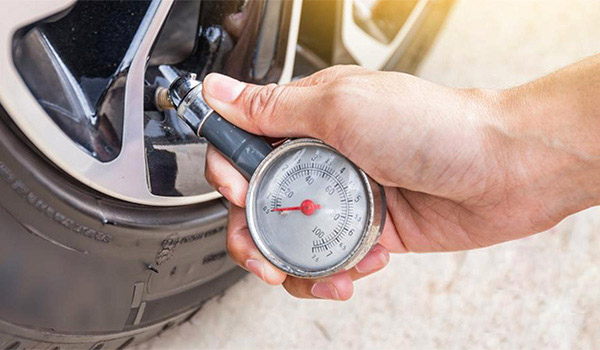As you’re cruising down the highway, you probably don’t often think of your car’s tires. But put just a little bit of ice and snow on the ground, or start maneuvering around tight hairpin turns, and it quickly becomes obvious how important your tires’ traction really is. And that traction, as well as almost everything about your tires’ performance, depends very strongly on proper tire pressure.

The trick of it is this: Even though it might look like your tires are fully touching the ground while you drive, they’re actually using a much smaller contact patch. And for the average tire, this area where the tire is actually touching the ground while you’re moving isn’t much bigger than the sole of your shoe.
When tires are at the correct pressure, this contact patch is perfectly sized for safe handling, good fuel efficiency, and even tire wear.
Too Much Air: The “High Heels” Effect
Overinflated tires create a contact patch that’s too small—think of trying to walk on ice in high heels. The result?
- Less traction
- Poor handling
- Uneven tire wear
- Increased risk of tire damage
Too Little Air: The “Clown Shoes” Effect
Underinflated tires create a patch that’s too big and sloppy—like walking in clown shoes. This leads to:
- Faster tread wear
- Extra rolling resistance (which lowers gas mileage)
- Sluggish handling
- Increased heat buildup (which can cause blowouts)
Right Tire Pressure, Better Gas Mileage
This isn’t just a fun analogy, though — it’s also backed up by science from the U.S. Department of Energy.
In a study from 2014, researchers at the Oak Ridge National Laboratory tested tires across a range of inflation pressures and highway driving speeds from 40 to 80 miles per hour. And their results were pretty amazing: In addition to being much safer to drive on, properly inflated tires can have as much as 10 percent better fuel economy compared to underinflated ones.
Checking Your Tires
Now that you know how important tire pressure can be, you might be wondering: How do your tires currently match up?
Most cars list an ideal tire pressure on a sticker inside of the driver’s side door; open your door and look down, and you should be able to find it pretty easily. Failing that, you can also find optimal tire pressure listed in the owner’s manual for your car.
Or you can save yourself the hassle, and bring your car by any of our Chapel Hill Tire locations to get the pressure checked and adjusted. That’s a great time to make sure your tire tread is in good shape too, so you can rest easy knowing that your car will get you from here to there and back again without any problems.